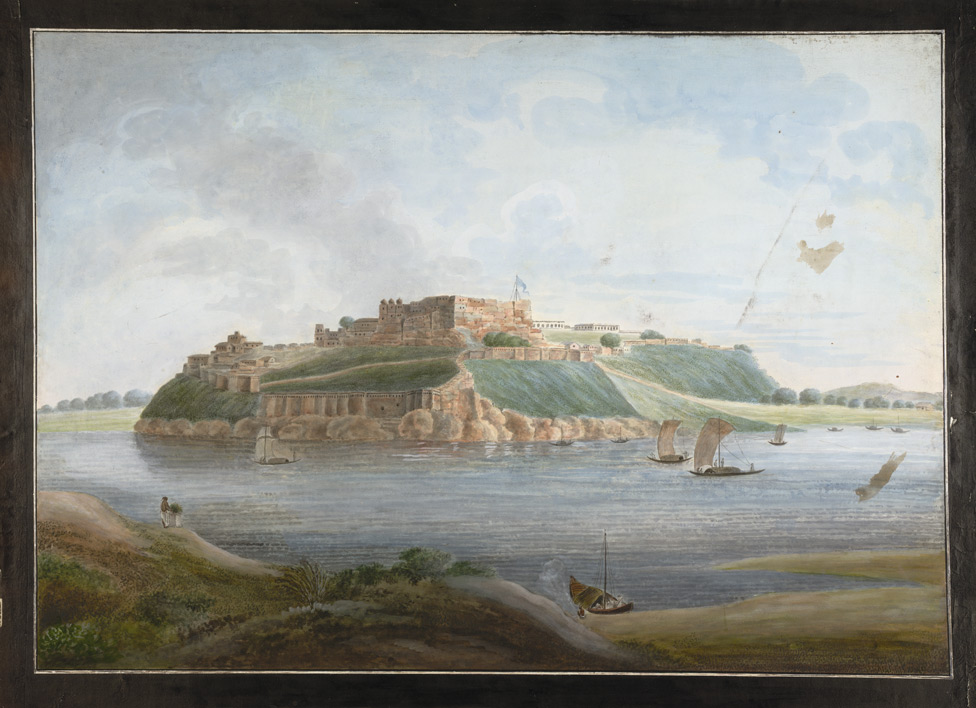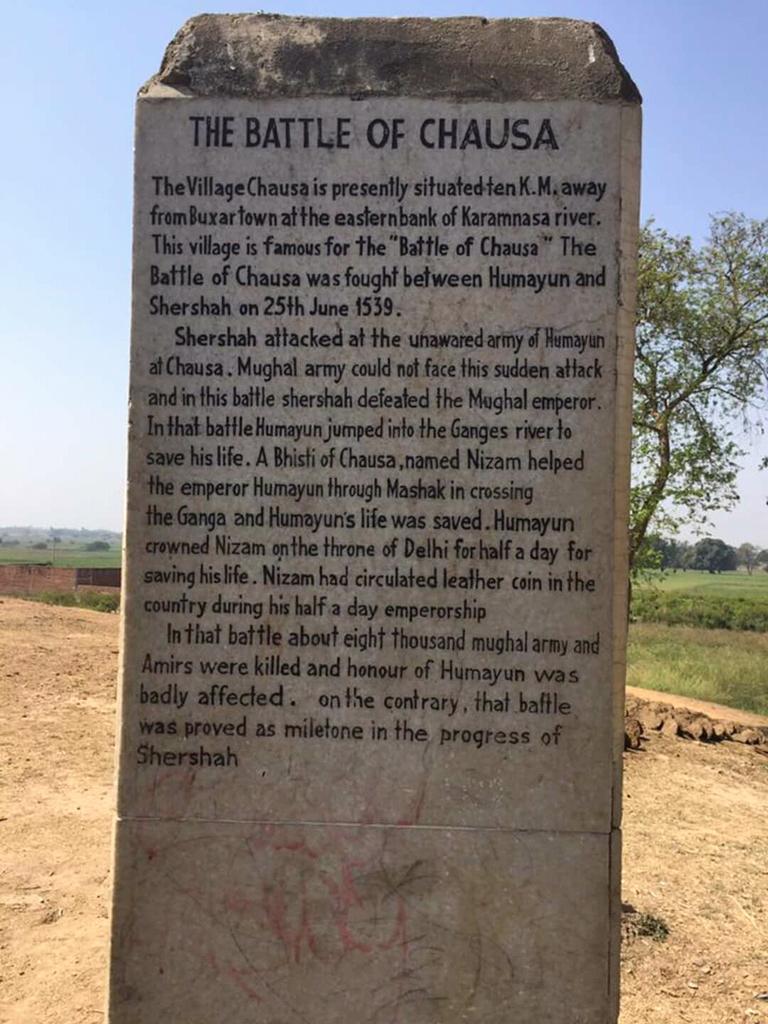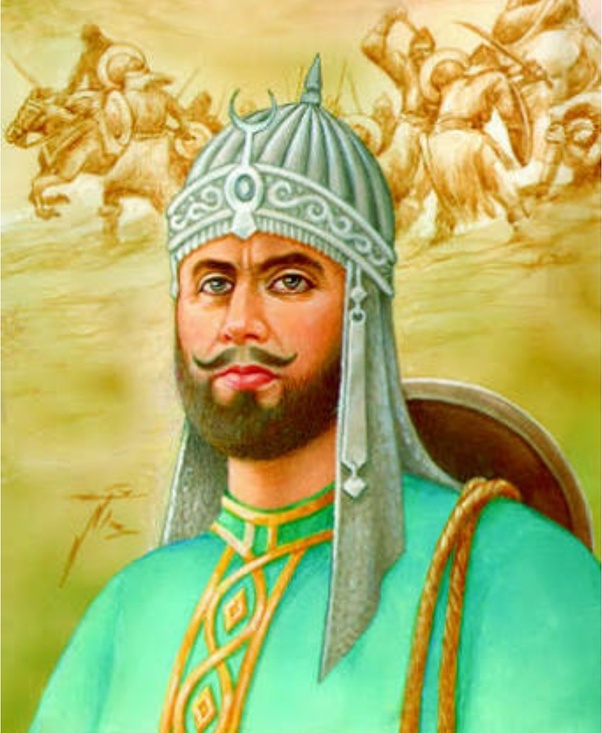While Humayun was busy fighting against Bahadur Shah, Sher Shah Suri consolidated his position in Bihar. He had become the master of south Bihar, owned the strong fort of Chunar, and most of the Afghan nobles had gathered under his banner. In Bengal, Nusrat Shah had died and his successor Mahmud Shah proved an incapable ruler.
That gave the further opportunity to Sher Khan to strengthen his power at the cost of Bengal. He attacked Bengal in 1536 A.D., besieged its capital Gaur and forced Mahmud Shah to pay thirteen lakh dinars. In 1537 A.D., he again attacked Bengal. Only then Humayun realized that it was necessary to subdue Sher Khan.

In July 1537 A.D, Humayun proceeded towards Bihar and first laid the siege of Chunargarh. Humayun was able to capture the fort after six months. In the meantime, Sher Khan had captured Gaur and looted all its treasure which he kept safe at the fort of Rohtasgarh. Humayun, thus, lost valuable time in the siege of Chunargarh.
Humayun reached Banaras and started negotiations with Sher Khan for peace. It was agreed that the province of Bengal would be handed over to Sher Khan under the suzerainty of the Mughals and he would pay ten lakh rupees annually while Bihar would be taken over by the Mughals. But before the treaty could be signed, a messenger of Mahmud Shah arrived and requested Humayun to attack Bengal to save his master.
Humayun broke off the negotiations with Sher Khan and proceeded towards Bengal. Sher Khan deputed his son Jalal Khan to delay the advance of Humayun. Jalal Khan successfully achieved his mission and returned to his father who had successfully finished his campaign in Bengal and returned to Bihar. Humayun, therefore, faced no difficulty in capturing Bengal.
During these months, Sher Khan captured Kara, Banaras, Sambhal, etc. and laid siege to Chunargarh and Jaunpur. He virtually blocked the way of return of Humayun to Agra. After some months, news of the activities of Sher Khan and also that of his brother Hindal who declared himself emperor at Agra were received by Humayun. He left Jahangir Quli Beg with five hundred soldiers in Bengal and proceeded towards Agra in March 1539 A.D.
The Battle of Chausa (26 June 1539 AD)

Humayun took the route of the Grand Trunk Road which passed through south Bihar which was under complete control of Sher Khan. According to Dr. A.L Srivastava, it was a great mistake. However, Humayun was forced to cross the river Ganges once more and he reached Chausa, a place at the boundary between Bihar and Uttar Pradesh. Sher Khan also reached there. The two armies remained there facing each other for three months (April to June 1539 A.D.). Negotiations of peace were carried on but nothing came out of them.
Sher Khan delayed the battle deliberately. He waited for the rains which would create problems for the Mughul army which was camping in the low land between the rivers Ganges and Karmanasa. That actually happened when the rains started. On 25 June he gave the impression to the Mughals that he was proceeding to subdue one of the tribal chiefs in Bihar. But, he returned and attacked the Mughals in the early hours of 26th June from three sides.
The Mughals were completely surprised and the entire army was destroyed. Humayun just saved his life by plunging himself into the river Ganges and crossing it with the help of a water-carrier, Nizam. Sher Khan declared himself the Sultan and assumed the title of Sher Shah after this battle. He captured Bengal as well and then returned to Kannauj.
The Battle of Bilgram or Kannauj (17 May 1540 A.D.)
While Sher Shah was consolidating his position in the east, Humayun and his brothers wasted their time at Agra. Humayun had generously pardoned not only his brother Hindal but also the rebel Sultan Mirza. Yet the brothers could not unite among themselves. Kamran fell ill and he grew suspicious that Humayun was poisoning him slowly.
Therefore, he left for Lahore with the larger part of his army. The Mughals, of course, defeated the Afghan army in Malwa which was sent by Sher Shah under his son Qutb Khan. But, they failed to take any effective measures against Sher Shah. However, Humayun finally moved towards the east and reached near Kannauj where Sher Shah had already encamped himself.

This time too the two armies faced each other for more than a month and again the rains started. On 17 May 1540 A.D when the Mughals were shifting themselves to a higher plain, Sher Shah attacked them. The Mughals fought valiantly but were defeated. Humayun again fled away.
The battle of Bilgram was the decisive battle between Humayun and Sher Shah. Humayun could reach Agra but had to fly from there as Sher Shah was pursuing him. Sher Shah captured Delhi and Agra and, thus, the Afghans snatched the throne of Delhi from the hands of the Mughals. Humayun first went to Lahore, then to Sindh, and, finally, left India to seek refuge at the court of Shah of Persia.
Causes of the Failure of Humayun against Sher Shah
There were various causes which resulted in the failure of Humayun against Sher Shah. He has expressed that the opposition of his brothers and weakness of his character as causes of his failure has been highly exaggerated by many historians which is an act of injustice to him.
Humayun divided his empire among his brothers because it was a tradition among the Timurids. If he had not done so, there was every possibility of a civil war among the brothers. The time, which he passed in Mandu after the conquests of Gujarat and in Gaur after the conquest of Bengal, was not passed in ease and comfort but in organizing the administration of these newly conquered states.
Among his brothers, Kamran did nothing against him for the first ten years of his rule. However, he lost faith in the capacity of Humayun to defend the empire and so left him to safeguard his own provinces. Askari never revolted against Humayun. On the contrary, he was always by the side of Humayun in all his important battles. He left Humayun to go with Kamran because he was his real brother.
Besides, he gave a chance to Humayun in escaping to Persia and looked after his son Akbar in his absence. Hindal possessed a weak personality. He revolted against Humayun mostly under the influence of others. Yet, he loved Humayun and, ultimately, died fighting for his sake.
If Kamran and Hindal would have gone to the support of Humayun before the battle of Chausa, probably, Humayun would have succeeded against Sher Shah. But the cause of their neglect at that time was more due to their miscalculations rather than bad intentions.
The major cause of the failure of Humayun was that his enemies possessed equally effective artillery. Another important cause was that Sher Shah was, certainly, a better and more experienced military commander than Humayun. Yet, another disadvantage of Humayun was his financial difficulty which he inherited from his father and which worsened further due to his generosity.
He lost Gujarat and Malwa because Tardi Beg refused to support Askari; Mahmud Shah of Bengal failed to defend himself against Sher Shah even for a few months; and, heavy rains disturbed the Mughul army before the battle of Kannauj.
Humayun in Exile (1540-1555 A.D.)
Humayun remained in exile for nearly fifteen years after his defeat at the battle of Kannauj. His efforts to go to Kashmir or Badakhshan were foiled by his brother Kamran. He then proceeded to Sindh and tried to capture it but failed. In 1541 A.D. he married Hamida Banu, the daughter of the spiritual preceptor of Hindal, Mir Ali Akbar Jani.
Hindal left for Kandhar at that time and another loyal officer of Humayun, Yadgar Mirza also left his company. Humayun proceeded towards Marwar. Its ruler Maldeva had assured of his help to Humayun about a year back. But, Humayun realized that he was not in a mood to help him at that time and, probably, was won over by Sher Shah to his side.
He immediately withdrew himself because he feared that Maldeva would imprison him and hand him over to Sher Shah. While returning from there he was given shelter by Virasala, the Rajput ruler of Amarkot where Akbar was born in 1542 A.D. Shah Husain, the ruler of south Sindh agreed to give passage and needful help to Humayun to proceed to Kandhar at that time and Humayun left India.
Kamran tried to capture him on the way but Humayun could reach Persia safely after leaving his infant son Akbar. Akbar was taken under the care of Askari who was the governor of Kandhar at that time. Shah Tahmasp, the ruler of Persia, welcomed Humayun and agreed to help him with money and soldiers in 1544 A.D. on condition that he would accept the Shia faith, propagate it among his subjects and restore Kandhar to Persia after its conquest.
Humayun had to accept that humiliating treaty and then he proceeded to attack Kandhar with the help of the Persian forces. Humayun captured Kandhar and Kabul from Kamran in 1545 A.D. and retained Kandhar to himself after the death of the son of Shah Tahmasp. Here he was joined back by Hindal and Yadgar Mirza. But, Kamran and Askari troubled him.
They were, however, defeated several times, pardoned by Humayun every time but, ultimately, were captured and punished. Kamran was blinded and allowed to proceed to Mecca where he died in 1557 A.D. Askari was also allowed to go to Mecca from where he never returned and died in 1558 A.D.

Hindal also fell fighting against the Afghans during this period. Thus, ultimately, Humayun became free from the rivalry of his brothers and settled himself in Afghanistan from where he got an opportunity to come back to India and recover his lost empire. In 1555 CE, Humayun was able to recover his Empire after the victory in the Battle of Machhiwara that marked the end of the Suri Dynasty.

